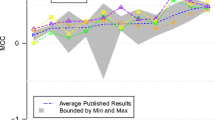Abstract
We compare the effectiveness of four modeling methods—negative binomial regression, recursive partitioning, random forests and Bayesian additive regression trees—for predicting the files likely to contain the most faults for 28 to 35 releases of three large industrial software systems. Predictor variables included lines of code, file age, faults in the previous release, changes in the previous two releases, and programming language. To compare the effectiveness of the different models, we use two metrics—the percent of faults contained in the top 20% of files identified by the model, and a new, more general metric, the fault-percentile-average. The negative binomial regression and random forests models performed significantly better than recursive partitioning and Bayesian additive regression trees, as assessed by either of the metrics. For each of the three systems, the negative binomial and random forests models identified 20% of the files in each release that contained an average of 76% to 94% of the faults.






Similar content being viewed by others
References
Adams EN (1984) Optimizing preventive service of software products. IBM J Res Develop 28(1):2–14
Arisholm E, Briand LC (2006) Predicting fault-prone components in a java legacy system. In: Proc ACM/IEEE ISESE, Rio de Janeiro
Basili VR, Perricone BT (1984) Software errors and complexity: an empirical investigation. Commun ACM 27(1):42–52
Bell RM, Ostrand TJ, Weyuker EJ (2006) Looking for bugs in all the right places. In: Proc ACM/international symposium on software testing and analysis (ISSTA2006), Portland, pp 61–71
Breiman L (2001) Random forests. Mach Learn 45:5–32
Breiman L, Friedman JH, Olshen RA, Stone CJ (1984) Classification and regression trees. Wadsworth, Belmont
Chipman HA, George EI, McCulloch RE (2008) BART: Bayesian additive regression trees. http://arxiv.org/abs/0806.3286v1
Denaro G, Pezze M (2002) An empirical evaluation of fault-proneness models. In: Proc international conf on software engineering (ICSE2002), Miami
Eick SG, Graves TL, Karr AF, Marron JS, Mockus A (2001) Does code decay? Assessing the evidence from change management data. IEEE Trans Softw Eng 27(1):1–12
Fenton NE, Ohlsson N (2000) Quantitative analysis of faults and failures in a complex software system. IEEE Trans Softw Eng 26(8):797–814
Friedman JH (1991) Multivariate adaptive regression splines. Ann Stat 19:1–67
Guo L, Ma Y, Cukic B, Singh H (2004) Robust prediction of fault-proneness by random forests. In: Proc ISSRE 2004, Saint-Malo
Hatton L (1997) Reexamining the fault density—component size connection. IEEE Softw 14:89–97
Jiang Y, Cukic B, Ma Y (2008) Techniques for evaluating fault prediction models. Empir Softw Eng 13:561–595
Khoshgoftaar TM, Allen EB, Kalaichelvan KS, Goel N (1996) Early quality prediction: a case study in telecommunications. IEEE Softw 13:65–71
Khoshgoftaar TM, Allen EB, Deng J (2002) Using regression trees to classify fault-prone software modules. IEEE Trans Reliab 51(4):455–462
Koru AG, Liu H (2005) An investigation of the effect of module size on defect prediction using static measures. In: 2005 Promise workshop, 15 May 2005
Lessmann S, Baesens B, Ues C, Pietsch S (2008) Benchmarking classification models for software defect prediction: a proposed framework and novel findings. IEEE Trans Softw Eng 34(4):485–496
McCullagh P, Nelder JA (1989) Generalized linear models, 2nd edn. Chapman and Hall, London
Menzies T, Di Stefano JS, Cunanan C, Chapman R (2004) Mining repositories to assist in project planning and resource allocation. In: International workshop on mining software repositories
Moeller K-H, Paulish DJ (1993) An empirical investigation of software fault distribution. In: Proc IEEE first international software metrics symposium, Baltimore, 21–22 May 1993, pp 82–90
Munson JC, Khoshgoftaar TM (1992) The detection of fault-prone programs. IEEE Trans Softw Eng 18(5):423–433
Ohlsson N, Alberg H (1996) Predicting fault-prone software modules in telephone switches. IEEE Trans Softw Eng 22(12):886–894
Ostrand T, Weyuker EJ (2002) The distribution of faults in a large industrial software system. In: Proc ACM/international symposium on software testing and analysis (ISSTA2002), Rome, pp 55–64
Ostrand T, Weyuker EJ (2007) How to measure success of software prediction models. In: Proc fourth international workshop on software quality assurance, Dubrovnik, September 2007
Ostrand TJ, Weyuker EJ, Bell RM (2005) Predicting the location and number of faults in large software systems. IEEE Trans Softw Eng 31(4):340–355
Ostrand TJ, Weyuker EJ, Bell RM (2007) Automating algorithms for the identification of fault-prone files. In: Proc ACM/international symposium on software testing and analysis (ISSTA07), London
Pighin M, Marzona A (2003) An empirical analysis of fault persistence through software releases. In: Proc IEEE/ACM ISESE 2003, pp 206–212
Succi G, Pedrycz W, Stefanovic M, Miller J (2003) Practical assessment of the models for identification of defect-prone classes in object-oriented commercial systems using design metrics. J Syst Softw 65(1):1–12
White H (1980) A heteroskedasticity-consistent covariance matrix estimator and a direct test for heteroskedasticity. Econometrics 48:817–838
Author information
Authors and Affiliations
Corresponding author
Additional information
Editor: G. Ruhe
Rights and permissions
About this article
Cite this article
Weyuker, E.J., Ostrand, T.J. & Bell, R.M. Comparing the effectiveness of several modeling methods for fault prediction. Empir Software Eng 15, 277–295 (2010). https://doi.org/10.1007/s10664-009-9111-2
Published:
Issue Date:
DOI: https://doi.org/10.1007/s10664-009-9111-2




